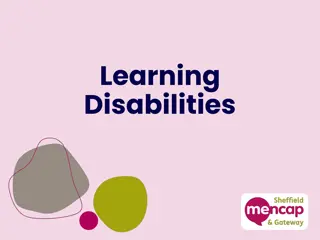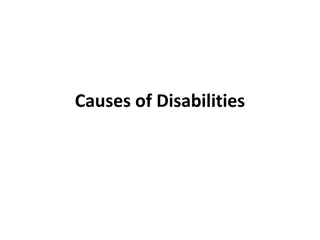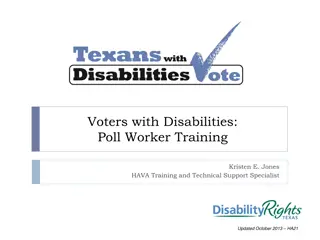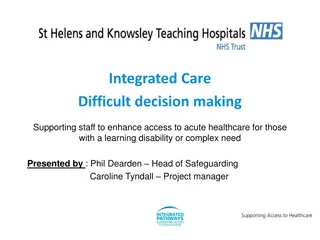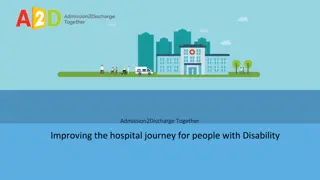Understanding Healthcare Rights for Individuals with Disabilities
Over 60 million Americans live with disabilities, and the number is growing. This guide covers the legal definition of disability, major life activities, laws such as the Rehabilitation Act of 1973 and the Americans with Disabilities Act of 1990, and empowering individuals with disabilities to assert their rights under the ADA.
Download Presentation

Please find below an Image/Link to download the presentation.
The content on the website is provided AS IS for your information and personal use only. It may not be sold, licensed, or shared on other websites without obtaining consent from the author. Download presentation by click this link. If you encounter any issues during the download, it is possible that the publisher has removed the file from their server.
E N D
Presentation Transcript
Healthcare for People with Disabilities STEPHANIE BREWER COOK CITY OF KNOXVILLE ADA COORDINATOR
Prevalence of People with Disabilities Over 60 million Americans (and counting!) Currently, one in four Americans have a disability Currently, one in three have a disabled family member Every day in the U.S.: 10,000 people turn age 65 This trend to continue until 2030 when there will be more people over age 65 than age 18 in the U.S. first time in history
What is a Disability? (the legal definition) Physical or mental impairment that substantially limits a major life activity Person has a record of having a physical or mental impairment that substantially limits a major life activity Person is regarded as having a physical or mental impairment that substantially limits a major life activity
Major Life Activities Walking Breathing Seeing Hearing Learning Performing manual tasks Reproductive, Digestive and other functions
Rehabilitation Act of 1973: Section 504 Federal law that stated any recipient of federal funds shall be accessible to and inclusive of people with disabilities Recipients of federal funds: state and local governments, public schools, public transportation and healthcare facilities (recipients of Medicare/Medicaid) Relied on voluntary compliance No enforcement mechanism
Americans with Disabilities Act of 1990 Federal civil rights law; signed on July 26, 1990 Most significant civil rights law in U.S. history for people with disabilities ensures rights to equal opportunity in employment, government/civic engagement, public accommodations (retail, entertainment, travel, tourism) Guarantees right to effective communication Provides a way to assert rights and ensure change to appropriately include individuals with disabilities
How People with Disabilities Assert Rights under the ADA Speak to person in charge about concern/problem Request a reasonable accommodation File a complaint with the head staff of agency File complaint with the federal government Hire an attorney and bring private lawsuit Educate and Accommodate or be prepared to Litigate
Common Negative Experiences in Healthcare Lack of staff training on people with disabilities/ADA Inadequate facility parking (not enough/not technically accessible ) Inadequate wayfinding signage to accessible features Insufficient accessibility: front counter, small or tight lobby areas with no place to park a mobility device
Negative Experiences in Healthcare continued Inaccessible scales Inaccessible exam rooms/equipment Lack of willingness to provide personal assistance Lack of willingness to listen to the person who has the disability regarding his or her unique needs Lack of willingness to trust the person s knowledge of his or her own body
Personal Anecdotes Woman who has a disability from birth that affects her ability to move limbs paralyzed except for her neck and head dependent on caregiver 24/7 sip/puff wheelchair Vaccinated against COVID but later got COVID Experienced months of inexplicable symptoms and had to wait on referral to a specialist to get an appointment; took four months to get in
Personal Anecdotes Day of appointment with the specialist Dependent on someone else for transportation, she arrived at specialist s office to find that there was no parking available to unload her. Called specialist s office to explain trying to park; am here and was put on hold. Office picked phone back up and said that specialist had a very busy day and since she was late, had to reschedule
Personal Anecdotes Family member rushed to emergency room Member of family who is dependent on accessible parking arrived at the ER to find that all accessible parking had been blocked off and reserved for COVID testing Disabled family member had to park almost three times as far away and had no help to get from the vehicle to ER; was a very difficult physical struggle
Personal Anecdotes Woman who is a little person has seen the same Gynecologist for years; one day the doctor was out and another doctor in the practice was available. Only one exam room has adjustable height examination table, but it was in use at the time Patient could not get on table without assistance and ended up not having a pelvic exam that day only talked with the doctor; had to reschedule
Personal Anecdotes Individual with a service animal fell ill and had to be transported to hospital via ambulance Upon arrival, nobody knew that the service animal is allowed to stay with the patient and separated them causing more stress for both A family member was found to come sit with the service animal and was returned to patient once more conscience (*ER nurse was familiar with service animals)
Personal Anecdotes Arrive at healthcare office Sign in and complete paperwork Nurse calls name at time of your appointment and as she opens door for you, loudly asks, so what s wrong here? Why are you in that wheelchair? Common question: What s wrong with you? Rather than focus on what brings the person to see the doctor, focus is on the disability which is often irrelevant
Personal Anecdotes People with disabilities can also be primary caregivers to a family member Person with a disability may have to accompany a parent to the doctor Examination rooms are often small add two people with mobility devices and they shrink Always good to have at least one exam room that is larger than the rest or a conference room for consult
Personal Anecdotes Woman who is a wheelchair user has a family history of breast cancer Gynecologist found lump and referred to breast specialist Patient had mammogram at specialist s office and was scheduled for a breast MRI to get further details On day of the MRI, staff called patient to explain, since the chart states you use a wheelchair, we will not be able to provide the MRI to you. Sorry.
Personal Anecdotes Woman is blind and her husband had a stroke While in ER with her husband, staff only addressed her daughter to ask questions/get information about him Woman stayed round the clock in hospital with husband Staff would speak to him, although he had difficulty communicating, and would ignore his wife s offering of assistance with communication although she knew of his history, symptoms and knew when anything changed
Health-related Social Needs Understand that disability is a normal part of the human experience Understand that most people aren t born with a disability Understand that the person is the expert on his/her body Understand that, upon arrival to office or hospital, there may be a need to be flexible to ensure that a space will work Understand that unique assistance may be required
Health-related Social Needs Public transportation for people with disabilities often must be reserved in advance As a result, the person may arrive very early or slightly late to a scheduled appointment When discharging a patient with a disability who has no personal transportation, be aware that it is not as simple as calling a cab
Meeting the Needs of People with Disabilities Don t assume this person using a walker is just like the last person you cared for who uses a walker Don t speak to the person as if there is something wrong with them simply because of an existing disability or because they may look different than most Don t assume that the person requires assistance, but be prepared to provide it if they do
Meeting the Needs of People with Disabilities Don t speak to the companion unless it is evident that the person with a disability cannot communicate his/her own needs independently Welcome opportunities to learn from anecdotal stories of your patients if they offer a suggestion to improve care Be willing to ask, How may I assist you? and then be teachable Understand that it s okay if everything isn t perfect as long as your effort is genuine
Making Healthcare More Accessible Facility renovations must include accessibility requirements Technological advancements allow for easier communication with people who have communication barriers learn what is available and have it ready for use Training of staff at all levels makes the experience less difficult and more comfortable for all involved Patient check-in processes, when accessible, make for a quicker experience (kiosk access, online access)
Making Healthcare More Accessible U.S. Access Board is the federal agency that investigates the built environment and makes recommendations on how to make physical spaces accessible to people with disabilities. Years of research goes into development of regulations before they become standards and are enforceable by the Department of Justice. Multiple online resources for more information
Telehealth Access Guidance on Nondiscrimination in Telehealth: Federal Protections to Ensure Accessibility to People with Disabilities and Limited English Proficient Persons (ada.gov)
Healthcare for People with Mobility Disabilities Access to Medical Care for Individuals with Mobility Disabilities | ADA.gov
Impact of COVID on Healthcare COVID-19 and the Americans with Disabilities Act | ADA.gov
Opioid Use Disorder The ADA and Opioid Use Disorder: Combating Discrimination Against People in Treatment or Recovery | ADA.gov
Steps to Take to Ensure Accessible Healthcare Understand that people with disabilities are people first and that their disability may require a little extra time to provide a service, more patience when communicating with them, and a need to think outside the box to find the best option that works for them BE WILLING
Steps to Take to Ensure Accessible Healthcare Understand that a solution that works for one person who is blind is a solution that worked for that person, but another solution may better fit someone else with a similar disability BE FLEXIBLE
Steps to Take to Ensure Accessible Healthcare Provide disability-related training to staff Prevalence of disability How to engage with patients and family members with disabilities Accessible features of the facility understand them, know where they are and how to find or use them
Steps to Take to Ensure Accessible Healthcare Learn more about reasonable accommodations and modifications in healthcare Create and implement policies inclusive of people with disabilities Increase accessibility by updating equipment Increase accessibility by renovating facilities
Steps to Take to Ensure Accessible Healthcare Review office or campus wayfinding information: does it include accessible spaces and features? Post a notice stating where to go for disability-related accommodation or complaint Add disability access to Patient s Bill of Rights Maintain accessible features (parking spaces, toilet stalls, etc.)
Were All in this TOGETHER Majority of people with disabilities are not born with a disability Approximately 80% of people with disabilities acquired the disability as the result of an injury, illness, debilitating health condition or aging We are all TABs : Temporarily Able Bodied
For More Information https://www.ada.gov/ JAN - Job Accommodation Network (askjan.org) Are you registered for the first webcast of the JAN 2024 Webcast Series? Don't miss "ADA & Beyond Compliance Considerations: Medical Documentation on Thursday, January 11, 2024, at 2:00 p.m. ET. Secure your spot today! #HR #ADA https://AskJAN.org/events/register/2024-Webcast-Series.cfm
Thank You For Listening! Stephanie B. Cook City of Knoxville ADA Coordinator Disability Services Office 400 Main Street, Suite 539 Knoxville, TN 37902 865-215-2034 office 865-216-6288 mobile scook@knoxvilletn.gov



